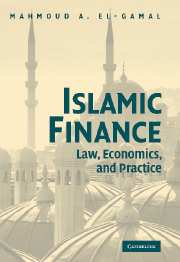Book contents
- Frontmatter
- Contents
- List of Illustrations
- Preface
- Glossary and Transliteration
- 1 Introduction
- 2 Jurisprudence and Arbitrage
- 3 Two Major Prohibitions: Riba and Gharar
- 4 Sale-Based Islamic Finance
- 5 Derivative-Like Sales: Salam, Istisna', and 'Urbun
- 6 Leasing, Securitization, and Sukuk
- 7 Partnerships and Equity Investment
- 8 Islamic Financial Institutions
- 9 Governance and Regulatory Solutions in Mutuality
- 10 Beyond Shari'a Arbitrage
- Conclusion
- Notes
- Bibliography
- Index
3 - Two Major Prohibitions: Riba and Gharar
Published online by Cambridge University Press: 06 July 2010
- Frontmatter
- Contents
- List of Illustrations
- Preface
- Glossary and Transliteration
- 1 Introduction
- 2 Jurisprudence and Arbitrage
- 3 Two Major Prohibitions: Riba and Gharar
- 4 Sale-Based Islamic Finance
- 5 Derivative-Like Sales: Salam, Istisna', and 'Urbun
- 6 Leasing, Securitization, and Sukuk
- 7 Partnerships and Equity Investment
- 8 Islamic Financial Institutions
- 9 Governance and Regulatory Solutions in Mutuality
- 10 Beyond Shari'a Arbitrage
- Conclusion
- Notes
- Bibliography
- Index
Summary
We have shown in Chapter 2 that Islamic finance is a prohibition-driven industry. In this regard, the instigating factor for prohibition-based contract invalidation can almost always be attributed to the two factors labeled riba and gharar. We have also shown in Chapter 1 that mainstream contemporary scholars of economic analysis of the law consider such prohibitions of mutually agreeable financial transactions paternalistic and conducive to efficiency losses. The formoriented nature of Islamic finance has done little to counter this claim for Islamic prohibitions.
Participants in the industry, especially ones who are not themselves devout Muslims, operationally respect Muslims' religious observance and devise financial solutions that avoid various prohibitions according to juristic opinion. This attitude has contributed further to the form-above-substance approach in Islamic finance: Lawyers and bankers are loath to challenge jurists' solutions as merely inefficient replications of what they had deemed forbidden transactions. To provide proper understanding of Islamic finance as practiced today, this chapter covers the economic substance that we believe was intended by the prohibitions. In later chapters we shall compare the economic substance of prohibitions and premodern nominate contract conditions in greater detail, comparing the form-oriented approach of contemporary Islamic finance to the substance-oriented classical jurisprudence.
Paternalism of Prohibitions
In the process of highlighting economic substance of prohibitions of riba and gharar in this chapter, we need to address two charges against prohibitions: paternalism and efficiency reduction.
- Type
- Chapter
- Information
- Islamic FinanceLaw, Economics, and Practice, pp. 46 - 63Publisher: Cambridge University PressPrint publication year: 2006



